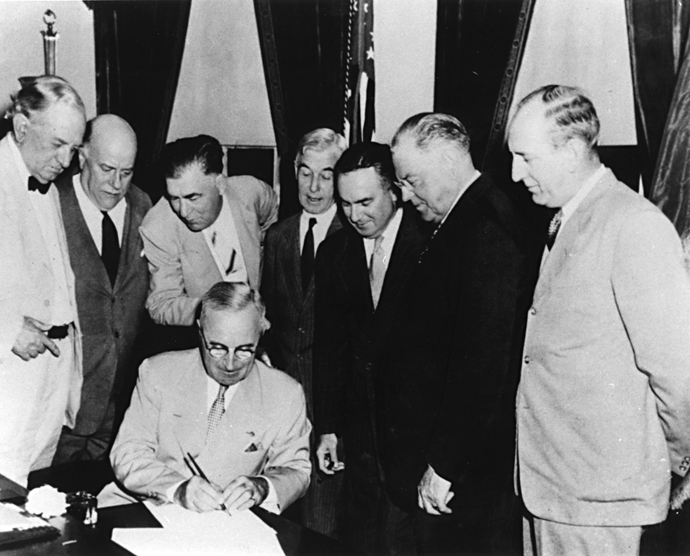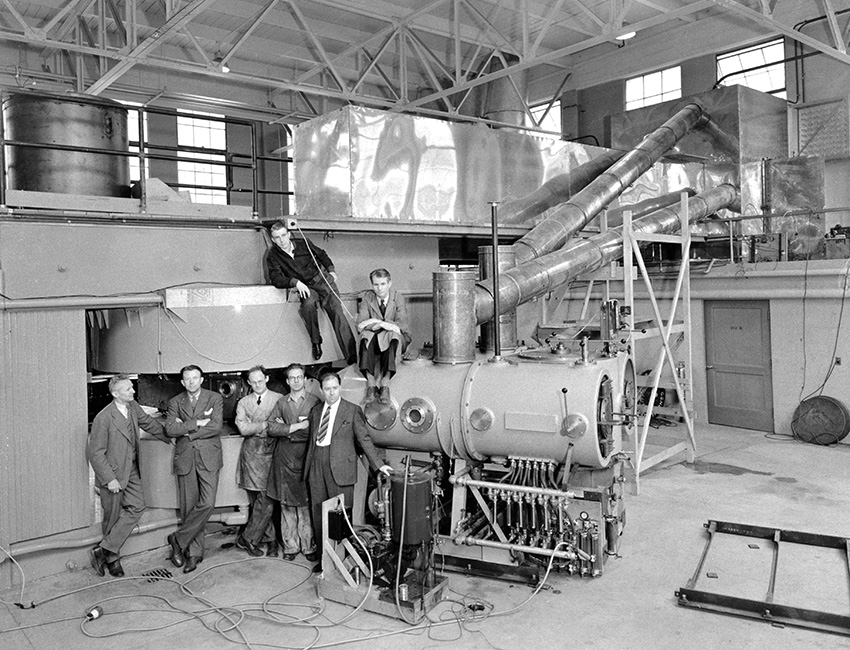History

Origins
The origins of the Office of Science trace to the Manhattan Project. The all-out effort to create the world’s first nuclear weapon created a vast research and development apparatus under the control of the War Department’s Army Corps of Engineers. The classified nature and sprawling logistical and technical demands of this work created large, multi-purpose facilities that became the nation’s first national laboratories.

Credit: Lawrence Berkeley National Laboratory
Posing with the newly completed 60-inch cyclotron in the Crocker Laboratory are (left to right) Donald Cooksey, Ernest O. Lawrence, R. Thornton, W. Salisbury and J. Backus and (on top) L. Alvarez and E. McMillan.
At the conclusion of World War II, the strategic importance of the nation’s scientific capabilities and nuclear technologies was unquestioned, but there was open debate as to whether the military should continue to oversee peacetime nuclear research was unsettled. In 1946, consensus on this issue emerged through enactment of the Atomic Energy Act, which transferred responsibility for nuclear research and development from the War Department to a new independent civilian agency, the Atomic Energy Commission (AEC), led by five Commissioners appointed by the President.
Credit: Department of Energy Office of History and Heritage
President Harry S Truman signs the Atomic Energy Act of 1946 establishing the U.S. Atomic Energy Commission. Behind the President, left to right: Senators Tom Connally, Eugene D. Millikin, Edwin C. Johnson, Thomas C. Hart, Brien McMahon, Warren R. Austin, and Richard B. Russell. (August 1, 1946.)
Caption: The Commission’s charter ensured continuity of the Manhattan Project research activities. It provided for a diversified program of basic research with emphases on basic nuclear processes, the production of nuclear energy, and the utilization of nuclear materials for medical, biological, health, or military purposes.
AEC Civilian Research Programs and the Rise of the National Laboratory System
The tools needed to carry out this mission were of a scale that required the federal government to construct and operate them. Throughout the 1940s and 1950s, the AEC created a network of national laboratories to host machines, such as particle accelerators and colliders and arrays of isotope-separating centrifuges, that became the foundation of this new nuclear science.
Lawrence Berkeley National Laboratory
The interior of the Linear Accelerator (LINAC), Lawrence Radiation Laboratory, 1957.
These new research tools not only enabled investigations of nuclear structure and reactions critical to the design of advanced fission weapons and energy systems, but they also revealed new frontiers of physics. Particle accelerators enabled the discovery of fundamental particles, revolutionizing physicists’ understanding of the fundamental laws of the universe. The spectrum of AEC-sponsored research activities and facilities continued to expand. In 1951, the Commission initiated a fusion energy research program to investigate the feasibility of using a controlled fusion reaction to generate electric power. The Commission also enhanced its research programs through contracts with industrial and academic institutions, and it fostered an unparalleled scientific and technical workforce.
Research and development programs in the 1960s and early 1970s revealed new knowledge of radiation and its effects and provided the necessary data to determine radiation protection standards and to assess the environmental impact of nuclear technology. Advances in medical diagnostic techniques based on the use of radioisotopes and radiation machines established significant new clinical capabilities. The national laboratory system also became a strategic platform for advanced computing systems and a variety of large-scale user facilities, such as unique light sources, that enabled a broad array of scientific research and technological innovation.
The Oil Embargo and Expansion of Federal Energy Research Activities
In 1971, early concerns about rising petroleum imports drove President Nixon and Congress to expand the AEC research charter to include non-nuclear forms of energy and related technologies. Three years later, the Arab oil embargo motivated a wave of energy-related national policy initiatives. The President proposed a new five-year, $10 billion energy research and development program, and a doubling of the total federal commitment to energy research and development for fiscal year 1975. Soon thereafter lawmakers terminated the AEC and placed its research functions under the newly created Energy Research and Development Administration (ERDA). ERDA consolidated existing energy research activities across the AEC and other agencies; its basic research portfolio included nuclear, solar, fossil, and geothermal energy, as well as conservation, synthetic fuels, and power transmission.
The DOE Era
Three years after the creation of ERDA, the establishment of DOE gathered under one authority most of the federal government’s energy-related research, policy, and regulatory activities (with the notable exception of regulation of the nuclear power industry, which became the exclusive duty of the newly created Nuclear Regulatory Commission). The Department of Energy Organization Act of 1977 specifically created the Office of Energy Research, led for the first time by a Presidential-appointed, Senate-confirmed Director, as the steward of DOE’s basic research portfolio.
Caption: On August 4, 1977, President Carter signed the Department of Energy Organization Act, consolidating more than 30 separate energy functions carried out by various government agencies, including ERDA.
The statutory duties and responsibilities of the Director of the Office of Energy Research were to advise the Secretary of Energy on DOE’s R&D programs, identify gaps or duplication in DOE R&D programs, direct the Department’s education activities, and manage grants and other forms of financial support for research activities. The Act also formally segregated management oversight of the Department’s weapons laboratories and non-weapons multipurpose laboratories, providing the Office of Energy Research authority over the latter. Following language in the 1977 Act, a formal division of the Department’s basic and applied research programs occurred early in DOE’s organizational evolution, with the Office of Energy Research retaining control over basic research programs.
Over the following two decades, the Office of Energy Research led a number of groundbreaking research and facilities projects that had wide impacts. The Office of Energy Research pioneered remote access for civilian researchers to supercomputers for open scientific research, created the Human Genome Project and the Global Climate Change Program, and conceived and constructed numerous large-scale open-access scientific user facilities. Building on the agency’s longstanding expertise in accelerator science, the Office developed and constructed an array of accelerator-based x-ray synchrotron light sources, particle colliders and detectors, and fusion energy experiments.
In 1998 the Energy and Water Development Appropriations Act changed the name of the Office of Energy Research to the Office of Science; the duties and responsibilities of the office were unchanged.
Today, the Office of Science proudly continues its longstanding leadership of fundamental scientific research for energy and the Nation’s largest supporter of basic research in the physical sciences.
| Activity/Agency | Years | Authorization |
|---|---|---|
| Manhattan Project | 1942 – 1946 | none |
| Atomic Energy Commission | 1946 – 1974 | P.L. 79-585 |
| Energy Research and Development Administration | 1974 – 1977 | P.L. 93-438 |
| Office of Energy Research | 1977 – 1998 | P.L. 95-91 |
| Office of Science | 1998 – present | P.L. 105-245 |




